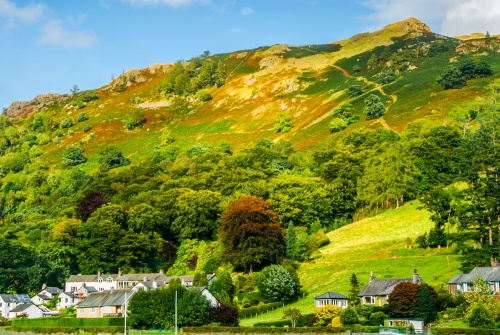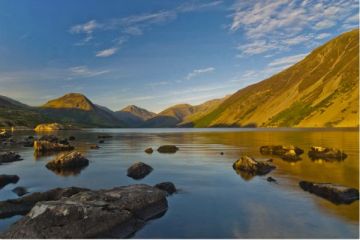
Grasmere village sits like a jewel in a bowl of hills, bounded on one side by the sparkling waters of Grasmere Lake. The village is one of the most popular and heavily visited destinations in the Lake District National Park. That's no surprise when you see its picturesque mix of rustic cottages roofed with blue slate jostling for space with large Victorian villas.

Most of the hordes of visitors that descend upon Grasmere are brought by its links to poet William Wordsworth.
From 1799-1813 Wordsworth lived at Dove Cottage, now owned by the National Trust. The whitewashed cottage is one of the most often photographed sites in the Lake District. The cottage was originally an inn known as the Dove and Olive Branch, but during Wordsworth's time, it was called Town End.
Beside the cottage is a modern museum dedicated to Wordsworth's life and works.
The poet and his beloved sister Dorothy are buried in the churchyard of St Oswald's Church in Grasmere, along with several other family members. A memorial to Wordsworth is set on the wall of the church nave.

St Oswald's is famous for its annual Rushbearing Ceremony, when a procession of children carry rushes to the church. The rushes, some arranged as crosses, others as garlands, decorate the church for a week, and loose rushes are used to cover the floor of the church. It's an inspiring sight to see the church decorated with rushes, creating echoes of the days when the church floor was of earth and rushes were an essential floor covering.
A few short steps from the churchyard is a historic little building that once served as the village school. It is now home to Grasmere Gingerbread, a scrumptious treat whose tasty fame has spread across Britain (and if one can judge by the lines outside the shop, it has become known abroad as well).

One of the newest attractions in Grasmere is also one of the oldest. Allan Bank is a large Georgian villa set on a hillside overlooking Grasmere Lake. Wordsworth stayed here before moving the Dove Cottage. The house was later owned by Canon Rawnsley, co-founder of the National Trust. There are wonderful woodland walks from Allan Bank, as our family can attest.
NB. Do not mistake Allan Bank in Grasmere with the National Trust garden at Acorn Bank, also in Cumbria, or Allen Banks (note the spelling), a Trust-owned nature area in Northumberland. Note that there is no parking at Allan Bank; you have to walk, but that's not really a hardship as Grasmere is so much fun to explore.
Visiting
Grasmere is easy to reach from both north and south. It is located on the A591, south of Keswick and north of Ambleside. There is a large pay and display parking area near the church.
About Grasmere
Address: Grasmere,
Lake District,
Cumbria,
England
Attraction Type: Village
Location: At the northernmost tip of Lake Windermere
Location map
OS: NY3406
Photo Credit: David Ross and Britain Express
HERITAGE
 We've 'tagged' this attraction information to help you find related historic attractions and learn more about major time periods mentioned.
We've 'tagged' this attraction information to help you find related historic attractions and learn more about major time periods mentioned.
Historic Time Periods:
Find other attractions tagged with:
13th century (Time Period) - 17th century (Time Period) - 7th century (Time Period) - St Oswald (Person) - Victorian (Time Period) - William Wordsworth (Person) -
NEARBY HISTORIC ATTRACTIONS
Heritage Rated from 1- 5 (low to exceptional) on historic interest
Grasmere - 0.4 miles (Countryside) ![]()
Loughrigg Fell - 0.4 miles (Countryside) ![]()
Dove Cottage & Wordsworth Museum - 0.7 miles (Historic Building) ![]()
Grasmere, St Oswald's Church - 0.9 miles (Historic Church) ![]()
Rydal Water - 1 miles (Countryside) ![]()
Allan Bank - 1.2 miles (Historic Building) ![]()
Rydal Mount - 1.5 miles (Historic Building) ![]()
Skelwith Force - 1.6 miles (Countryside) ![]()











